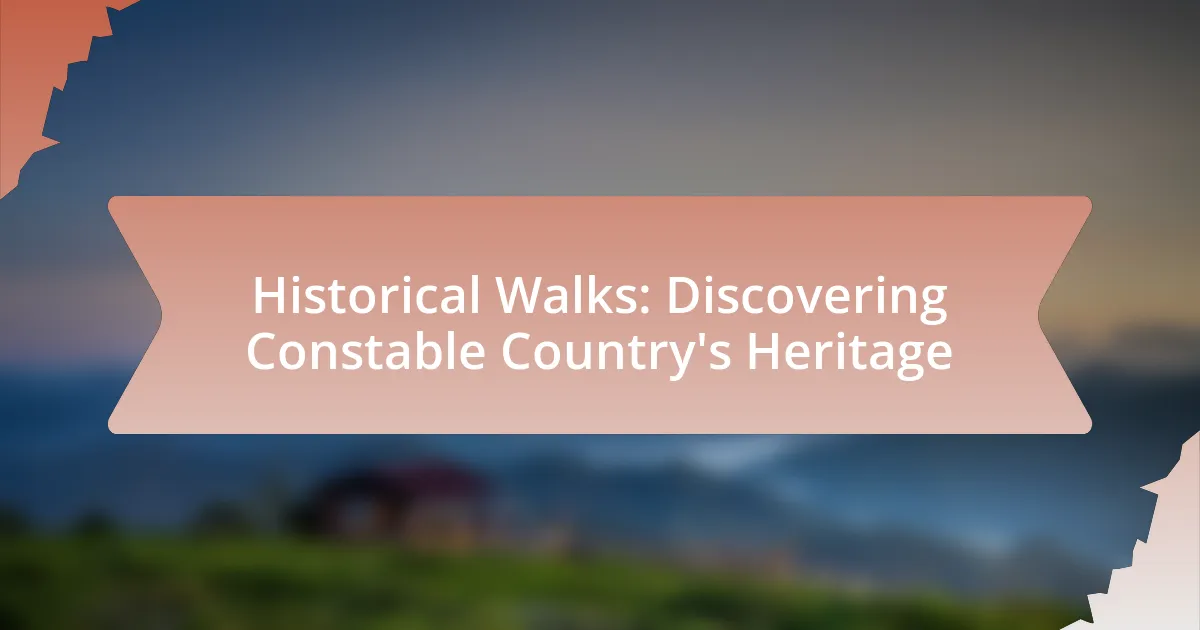Constable Country, located in Suffolk, England, is a historically significant area named after the landscape painter John Constable, who captured its rural beauty in the early 19th century. The article explores the cultural heritage of Constable Country, detailing its connection to Constable’s iconic works, such as “The Hay Wain” and “Dedham Vale,” and the impact of the Industrial Revolution on the landscape. It highlights recommended historical walks, key landmarks, and essential preparations for visitors, emphasizing the importance of respecting local heritage while enjoying the area’s natural beauty. Additionally, the article discusses local events and resources available for those interested in deepening their understanding of Constable Country’s rich history.

What is Constable Country and its Historical Significance?
Constable Country is a picturesque area in Suffolk, England, renowned for its association with the landscape painter John Constable, who depicted its rural scenes in the early 19th century. The historical significance of Constable Country lies in its representation of the English countryside during a time of industrial change, capturing the beauty and tranquility of rural life, which influenced the Romantic movement in art. Constable’s works, such as “The Hay Wain” and “Dedham Vale,” not only reflect the natural beauty of the region but also serve as historical documents that illustrate the agricultural practices and social conditions of the time, making Constable Country a vital part of England’s cultural heritage.
How did Constable Country get its name?
Constable Country got its name from the renowned English landscape painter John Constable, who was born in Suffolk and famously depicted the area’s rural scenery in his artwork. His paintings, such as “The Hay Wain” and “Dedham Vale,” captured the beauty of the landscape, leading to the region being associated with his name. The term “Constable Country” reflects the cultural and historical significance of the area as a source of inspiration for his work, which has contributed to its recognition and preservation as a heritage site.
What role did John Constable play in the region’s heritage?
John Constable significantly shaped the region’s heritage by capturing its landscapes through his paintings, which reflect the natural beauty and rural life of Suffolk, England. His works, such as “The Hay Wain” and “Dedham Vale,” not only depict the local scenery but also evoke a sense of place and identity for the area known as Constable Country. These paintings have become iconic representations of the English countryside, influencing perceptions of rural heritage and contributing to the cultural legacy of the region. Constable’s emphasis on naturalism and his dedication to portraying the local environment have solidified his role as a key figure in the artistic heritage of Suffolk.
What are the key historical events associated with Constable Country?
Key historical events associated with Constable Country include the establishment of the area as a significant artistic landscape in the early 19th century, primarily due to the works of painter John Constable, who was born in East Bergholt in 1776. His paintings, such as “The Hay Wain” and “Dedham Vale,” captured the rural beauty of the Suffolk countryside, influencing perceptions of the region. Additionally, the Industrial Revolution brought changes to the landscape, with the construction of railways and mills, impacting local agriculture and society. The area was also designated as a conservation zone in the late 20th century, preserving its historical and natural heritage for future generations.
Why is Constable Country important for heritage walks?
Constable Country is important for heritage walks because it showcases the landscapes that inspired the renowned artist John Constable, reflecting the cultural and historical significance of the area. The region, located in Suffolk, England, features iconic scenes such as the Stour Valley and Dedham Vale, which are preserved as Areas of Outstanding Natural Beauty. These landscapes not only provide a picturesque setting for walking but also offer insights into 19th-century rural life, as evidenced by the preserved architecture and farming practices that Constable depicted in his paintings. The connection to Constable’s work enhances the educational value of heritage walks, allowing visitors to appreciate both the natural beauty and the artistic legacy of the region.
What unique features of Constable Country attract walkers?
Constable Country attracts walkers due to its picturesque landscapes, rich artistic heritage, and well-maintained walking trails. The area is renowned for its scenic beauty, characterized by rolling hills, lush meadows, and the River Stour, which inspired the famous painter John Constable. Walkers can explore the same vistas that Constable captured in his artwork, providing a unique connection to history. Additionally, the presence of historical landmarks, such as Flatford Mill and Dedham Vale, enhances the walking experience by offering insights into the region’s cultural significance. These features collectively create an appealing environment for walkers seeking both natural beauty and historical context.
How does the landscape reflect the historical context of the area?
The landscape of Constable Country reflects its historical context through its preserved rural features and artistic representations. The area, known for its picturesque scenery, has been shaped by agricultural practices dating back centuries, which are evident in the patchwork of fields, hedgerows, and waterways. Notably, the works of artist John Constable, who depicted the landscape in the early 19th century, highlight the cultural significance of these natural elements, showcasing how they influenced local identity and heritage. The presence of historical structures, such as churches and mills, further illustrates the region’s development and the relationship between the land and its inhabitants over time.

What are the Best Historical Walks in Constable Country?
The best historical walks in Constable Country include the Dedham Vale Circular Walk, the Flatford Mill to Dedham Walk, and the Stour Valley Path. The Dedham Vale Circular Walk offers scenic views and historical landmarks, such as the picturesque village of Dedham and the iconic landscapes painted by John Constable. The Flatford Mill to Dedham Walk follows the River Stour, showcasing the area’s natural beauty and historical significance, including Flatford Mill, which is associated with Constable’s artwork. The Stour Valley Path is a longer route that connects various historical sites along the river, providing insights into the region’s cultural heritage. These walks not only highlight the stunning landscapes but also the rich history of Constable Country, making them ideal for those interested in both nature and heritage.
Which routes are recommended for exploring Constable Country?
The recommended routes for exploring Constable Country include the Dedham Vale Circular Walk, the Flatford to Dedham Walk, and the Stour Valley Path. These routes showcase the picturesque landscapes that inspired John Constable’s paintings, such as the iconic scenes around Flatford Mill and Dedham. The Dedham Vale Circular Walk spans approximately 6 miles, offering views of the River Stour and the surrounding countryside, while the Flatford to Dedham Walk is about 3 miles and highlights key locations from Constable’s works. The Stour Valley Path extends over 60 miles, providing a comprehensive exploration of the area’s natural beauty and heritage.
What landmarks can be seen along these historical walks?
Landmarks along the historical walks in Constable Country include Flatford Mill, Dedham Vale, and the picturesque village of East Bergholt. Flatford Mill, famously depicted in John Constable’s paintings, serves as a key point of interest, showcasing the area’s rich artistic heritage. Dedham Vale, designated as an Area of Outstanding Natural Beauty, offers stunning landscapes that inspired many of Constable’s works. East Bergholt, the birthplace of John Constable, features historical buildings and sites that reflect the local culture and history. These landmarks collectively highlight the significance of Constable Country’s heritage and its influence on art and history.
How long do these walks typically take?
These walks typically take between two to four hours to complete. The duration depends on the specific route chosen and the pace of the participants. For instance, shorter walks may last around two hours, while more extensive routes can extend to four hours, allowing for exploration of key historical sites and natural landscapes in Constable Country.
What should walkers know before embarking on these historical walks?
Walkers should know that historical walks in Constable Country require preparation and awareness of the area’s cultural significance. Understanding the historical context, such as the influence of artist John Constable and the landscapes he depicted, enhances the experience. Additionally, walkers should be aware of the terrain and weather conditions, as well as the availability of maps and guides that highlight key historical sites. Familiarity with local regulations and respect for the environment are also crucial for a safe and enjoyable journey.
What are the essential preparations for a historical walk in Constable Country?
Essential preparations for a historical walk in Constable Country include planning your route, checking the weather, and ensuring you have appropriate footwear. Planning your route is crucial as Constable Country features various trails that highlight its artistic and historical significance, such as the landscapes that inspired John Constable’s paintings. Checking the weather is important to dress appropriately and stay safe during the walk, as conditions can change rapidly in rural areas. Wearing sturdy footwear is essential for navigating uneven terrain and ensuring comfort throughout the walk.
How can walkers ensure they respect the local heritage during their journey?
Walkers can ensure they respect local heritage during their journey by adhering to established guidelines and practices that honor the cultural and historical significance of the area. This includes staying on marked paths to prevent damage to archaeological sites and natural habitats, which is crucial as many regions, including Constable Country, contain sensitive landscapes and historical landmarks. Additionally, walkers should educate themselves about the local history and customs, fostering a deeper appreciation for the heritage they are experiencing. Engaging with local communities and supporting local businesses also contributes to the preservation of cultural identity, as it encourages sustainable tourism practices.
How can visitors enhance their experience of Constable Country’s Heritage?
Visitors can enhance their experience of Constable Country’s Heritage by participating in guided historical walks that focus on the landscapes and sites depicted in John Constable’s paintings. These walks provide context and insights into the artist’s life and the historical significance of the area, allowing visitors to connect more deeply with the heritage. For example, the Dedham Vale Area of Outstanding Natural Beauty offers trails that lead to key locations such as Flatford Mill and Willy Lott’s Cottage, which are integral to Constable’s work. Engaging with local guides who share stories and historical facts about the region further enriches the experience, making it both educational and immersive.
What resources are available for learning about Constable Country’s history?
Resources for learning about Constable Country’s history include local museums, historical societies, and published literature. The Dedham Vale AONB (Area of Outstanding Natural Beauty) offers educational materials and guided walks that highlight the area’s artistic and historical significance, particularly related to the painter John Constable. Additionally, books such as “Constable Country: The Landscape of John Constable” provide in-depth insights into the region’s heritage. Online resources, including the National Trust website, also offer historical context and visitor information about key sites in Constable Country.
How can guided tours enrich the walking experience?
Guided tours can enrich the walking experience by providing in-depth knowledge and context about the historical and cultural significance of the locations visited. These tours often include expert guides who share stories, facts, and insights that enhance understanding and appreciation of the area’s heritage. For instance, in Constable Country, guided tours can highlight the landscapes that inspired John Constable’s paintings, offering participants a deeper connection to both the art and the environment. This educational aspect transforms a simple walk into an immersive experience, allowing walkers to engage with the history and culture in a meaningful way.
What local events or festivals celebrate Constable Country’s heritage?
Local events that celebrate Constable Country’s heritage include the Dedham Vale Festival and the Flatford Mill Arts and Crafts Festival. The Dedham Vale Festival, held annually, showcases local art, music, and food, reflecting the area’s cultural significance and its connection to the artist John Constable. The Flatford Mill Arts and Crafts Festival features local artisans and craftspeople, emphasizing the traditional skills and heritage of the region. These festivals not only honor the artistic legacy of Constable but also promote community engagement and appreciation for the natural beauty of Constable Country.
What practical tips can enhance a historical walk in Constable Country?
To enhance a historical walk in Constable Country, visitors should consider using a detailed map or guidebook that highlights key sites related to John Constable’s life and works. This approach allows walkers to navigate effectively and appreciate the landscape that inspired Constable’s paintings, such as Flatford Mill and Dedham Vale. Additionally, engaging with local historical societies or guided tours can provide deeper insights into the area’s cultural significance and historical context, enriching the overall experience. These resources ensure that walkers not only enjoy the scenery but also understand the historical narratives tied to the locations they visit.
What are the best times of year to visit for historical walks?
The best times of year to visit for historical walks in Constable Country are spring (April to June) and autumn (September to October). During spring, the weather is mild, and the landscape is vibrant with blooming flowers, enhancing the historical scenery. Autumn offers pleasant temperatures and stunning foliage, making it ideal for exploring historical sites. Both seasons provide optimal conditions for walking, allowing visitors to fully appreciate the rich heritage and natural beauty of the area.
How can walkers stay safe and comfortable during their explorations?
Walkers can stay safe and comfortable during their explorations by wearing appropriate footwear, carrying sufficient water, and being aware of their surroundings. Proper footwear, such as hiking boots, provides necessary support and traction, reducing the risk of slips and injuries on uneven terrain. Staying hydrated is crucial, as dehydration can lead to fatigue and decreased alertness, which are safety concerns. Additionally, being aware of the environment, including weather conditions and potential hazards like wildlife or difficult paths, helps walkers make informed decisions and avoid dangerous situations. These practices are supported by outdoor safety guidelines from organizations like the American Hiking Society, which emphasize preparation and awareness as key components of safe hiking.


